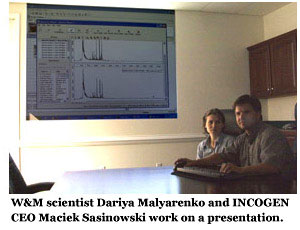College receives funding for early cancer detection research
The College of William and Mary has received
a $472,409 grant from the National Cancer Institute to advance
proteomics/bioinformatics technology that ultimately could result in
improved sensitivity of cancer detection.
The three-year funding supports a collaborative effort involving around 25 physicists, biologists, statisticians, computational scientists and health-care professionals from William and Mary, Eastern Virginia Medical School (EVMS), the Applied Research Center and INCOGEN, a Williamsburg bioinformatics firm. Dariya Malyarenko and Tina Bunai, research scientists at William and Mary, are principal investigators on the project, along with Maciek Sasinowski of INCOGEN and John Semmes of EVMS.
Proteomics is the study of the myriad of proteins that make up the body’s cells. Some of the body’s proteins can be used as “biomarkers,” indicators of the presence of a certain disease, such as cancer.
Malyarenko explains that the William and Mary collaboration uses a technique known as MALDI-TOF (matrix-assisted laser desorption/ ionization time-of-flight), a variety of mass spectrometry to analyze samples provided by specialists in early cancer detection at EVMS. The MALDI-TOF process involves using a laser to ionize protein molecules from tissue or body fluid samples, which are then separated by mass-to-charge ratio and registered for abundance in a mass spectrometer. The data from MALDI-TOF is processed through bioinformatics tools, optimized using a software package developed by INCOGEN.
The goal is to use the process to develop an accurate, non-invasive early cancer-detection process, said Sasinowski, CEO of INCOGEN. Once the technique is fully developed, a patient’s blood or urine sample will be analyzed for the presence of specific proteins that indicate the presence of cancer. The group faces two sets of related challenges: the first deals with how to identify target proteins from among the hundreds present. The second set of challenges is related to perfecting the detection process itself. Mass spectrometry inherently generates a certain amount of unwanted data known as “noise,” which clutters the results, making it even more difficult to find the targeted biomarkers.
“The analysis is just extraordinarily complex, because there are just so many proteins in the blood. Even separating the real data from the noise is very difficult. That’s where people like Dr. Malyarenko come in,” Sasinowski said.
“There are two sources of noise, One is electronic noise, which refers to signal-to-noise ratio. But there is also the issue of chemical noise, or ionization noise, which is connected to the technique itself. Both of them are big problems,” Malyarenko said. “This grant will allow us to further develop computational tools that can be useful for the cancer research community analyzing large volume of proteomics MS data.”
End users of the process can either use open-source packages developed by W&M or INCOGEN’s software, known as VIBE. Originally written to facilitate analysis of DNA sequences, the revised proteomics-oriented VIBE-MS (mass spectrometry toolkit) will make cancer biomarker data analysis user-friendly for medical professionals.














